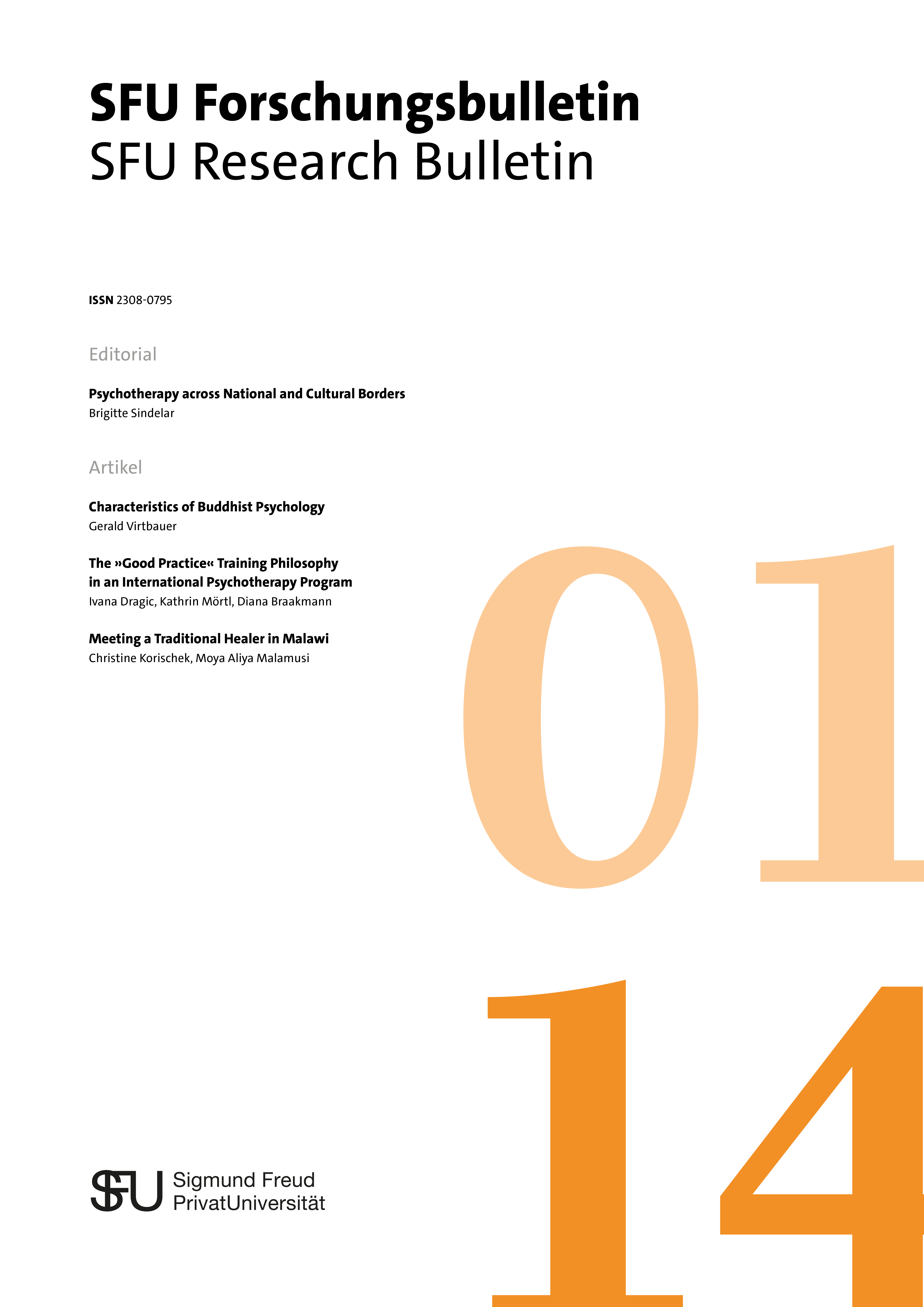Meeting a Traditional Healer in Malawi
DOI:
https://doi.org/10.15135/2014.2.1.36-67Abstract
The present article gives an ethnographic account of a healing practice in southern Malawi as observed by the research group of SFU students in July 2013. The paper is a product of an experimental writing process. Besides describing the healing practice of Dorothy Anderson, mechanisms of the psychology of culture contact are made transparent in the individual narrations of the participants and are discussed in the conclusion.
References
Clifford, J., Marcus, G. E. (Eds.) (1986). Writing Culture. The Poetics and Politics of Ethnography. Berkeley: University of California Press.
Collomb, H. (1976). Hexerei – Menschenfresserei und Zweierbeziehung. Übersetzung: Paul Parin. Nach einem Vortrag gehalten am „International Congress of Psychoanalysis and Madness“, Mailand, 1.-4.12.1976. Parin Nachlass.
Devereux, G. (1967). Angst und Methode in den Verhaltenswissenschaften. München: Hanser Verlag.
Dimt, G. (1996). Frösche, Kröten, Salamander. Ein ethnologischer Streifzug durch die Welt der Lurche. In: Hödl, W. (Hrsg.). (1996). Frösche, Kröten, Unken - Aus der Welt der Amphibien. Linz: Land Oberösterreich, OÖ. Landesmuseum.
Duerr, H.-P. (1985). Traumzeit. Über die Grenze zwischen Wildnis und Zivilisation. Frankfurt am Main: Suhrkamp Verlag.
Evans-Pritchard, E. E. (1976). Witchcraft, Oracles and Magic Among the Azande. Oxford: Oxford University Press.
Frazer, J. G. (1968). Der goldene Zweig. Eine Studie über Magie und Religion. Köln: Kiepenheuer & Witsch.
Geertz, C. (1988). Works and Lives, the Anthropologist as Author. Stanford: Stanford University Press.
Geschiere, P. (1997). The Modernity of Witchcraft. Politics and the Occult in Post-colonial Africa. Charlottesville: University of Virginia Press.
Hahn, H. P. (2013). Ethnologie. Eine Einführung. Berlin: Suhrkamp Verlag.
Hirschberg, W. (1988). Frosch und Kröte in Mythos und Brauch. Wien: Böhlau Ver-lag.
Herrmann, H. J. (1996). Skizzen zur Kulturgeschichte der Frösche. In: Hödl, W. (Hrsg.). (1996). Frösche, Kröten, Unken - Aus der Welt der Amphibien. Linz: Land Oberösterreich, OÖ. Landesmuseum.
Hödl, W. (Hrsg.). (1996). Frösche, Kröten, Unken - Aus der Welt der Amphibien. Linz: Land Oberösterreich, OÖ. Landesmuseum.
Kubik, G. (1992). Ethnicity, Cultural Identity, and the Psychology of Culture Contact. In: Béhague, G. H. (Ed). (1992). Music and Black Ethnicity: the Caribbean and South American. Miami: Transaction Publishers, 17-46.
Kubik, G. (2004). Hexerei Global. Gedanken zu Hexerei-Beschuldigungen in Afrika, im Irak und zu den kognitiven Grundlagen einer interkulturellen Tiefenpsychologie. In: Psychoanalyse – Texte zur Sozialforschung, 8, Heft 2 (15), 214-227.
Kubik, G. (2009). Das ‚Eigene‘ und das ‚Fremde‘. In: Blomann, U. J., Heßler, H.-J. (Hrsg.). Rastlose Brückenbauerin. Festschrift zum 80. Geburtstag von Ilse Strobl. Duisburg: NonEM-Verlag, 197-214.
Kutalek, R. (2003). Medizinische Systeme in Afrika. In: Greifeld, K (Hrsg.) (2003). Ritual und Heilung. Eine Einführung in die Medizinethnologie. 3. Aufl. Berlin: Dietrich Reimer, 39-67.
Langbein, K. (2014). Weissbuch Heilung. Wenn die moderne Medizin nichts mehr tun kann. Salzburg: Ecowin.
Malamusi, M. A. (1999). Ufiti ndi Using’anga – Witchcraft and Healing Practice. A Culture & Personality Study of Traditional Healers in South Malawi. Wien: Universität Wien, Diplomarbeit.
Parin, P., Morgenthaler, F., Parin-Matthèy, G. (1971). Fürchte deinen Nächsten wie dich selbst. Psychoanalyse und Gesellschaft am Modell der Agni in Westafrika. Frankfurt am Main: Suhrkamp Verlag.
Peltzer, K. (1985). Some Contributions of Traditional Healing Practices Towards Psychological Health in Malawi. Lilongwe: University of Malawi, Dissertation.
Randi, James (1997): An Encyclopedia of Claims, Frauds, and Hoaxes of the Occult and Supernatural. New York: St. Martin´s Press L.L.C. Retrieved from http://www.randi.org/encyclopedia/native%20healer.html, 14.03.2014
Röhring, L. (1974). Märchen und Wirklichkeit. Eine volkstümliche Untersuchung. Wiesbaden: Steiner Verlag.
Schwamberger, C. (2014). Heilerwesen in Bulgarien. Traditionelle Heilerinnen versus Psychotherapeutinnen. Münster: Waxmann.
Shioya, N. (2009) Der Jungbrunnen des Dr. Shioya. Burgrain: KOHA.
Taussig, M. (2013). Sympathiezauber. Texte zur Ethnographie. Konstanz: Konstanz University Press.
Soko, B., Kubik, G. (2002). Nchimi Chikanga: The Battle against Witchcraft in Malawi. Blantyre: Christian Literature Association in Malawi.
Downloads
Published
Issue
Section
License
The reproduction of articles published in any form is allowed under the condition that the citation is comprehensive. Prints in other publication media or public media require the written consent of the editor and can be requested under: forschung@sfu.ac.at
